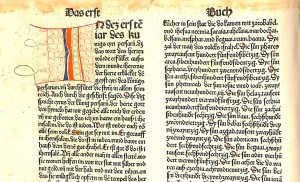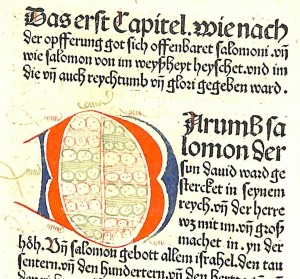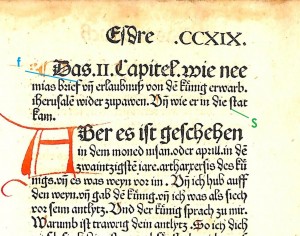One of the titles we will be showing in two upcoming instruction sessions this week, the 1483 Leaves from the Ninth German Bible (Biblia Nona Germanica), is the only one of our nine titles printed before 1500 that is in a language other than Latin. It was printed by Anton Koberger (1440-1513), a goldsmith, printer, publisher and bookseller in Nuernberg. By the end of the 15th century, Koberger's business is believed to have been one of the most important printing shops in Europe.
Although we only have a portion, to be exact, 144 pages of this Bible, the fragment is nevertheless a wonderful example of a clearly printed and well-composed early Gothic font that is surprisingly legible to the modern reader.
 Excerpt from a page of Anton Koberger's Ninth German Bible (Biblia Nona Germanica), Rare Book BS237 1483.
Excerpt from a page of Anton Koberger's Ninth German Bible (Biblia Nona Germanica), Rare Book BS237 1483.
Like so many of the early printed books, Koberger’s Bible follows the tradition of manuscript volumes by coloring and decorating the first letters of sections, and often embellishing the text by adding illustrations throughout. This very time-consuming task was done by hand by so-called rubricators and illuminators, but since the printing process multiplied the number of produced volumes exponentially, this costly post-printing step was completed on a less and less regular basis with the advent of printing. While our partial copy shows consistent rubrication, it unfortunately misses examples of the elaborate woodcuts that can be found in the more complete copies of the Bible.
 This enlarged excerpt from a page of Anton Koberger's Ninth German Bible (Biblia Nona Germanica), Rare Book BS237 1483, highlights one of the hand colored initials.
This enlarged excerpt from a page of Anton Koberger's Ninth German Bible (Biblia Nona Germanica), Rare Book BS237 1483, highlights one of the hand colored initials.
When showing this, or other books in a similar font, in our classes one question students invariably ask is why the letter ‘s’ looks like the ‘f.’ Early print fonts emulated handwriting styles of their time period, so for the readers of the time, this similarity would not have been cause for confusion. And if you look closely at the letters I highlighted in the example below with blue and green lines, you can see the tiny horizontal stroke that distinguishes the ‘f’ in "brief" from the ‘s’ in 'stat.'
 Excerpt from a page of Anton Koberger's Ninth German Bible (Biblia Nona Germanica), Rare Book BS237 1483.
According to Oscar Hase in his book Die Koberger (1885), Koberger’s Bible text was based on a vernacular translation by the Waldensians (a Christian movement that had been excommunicated and denounced as heretic) and - though adapted by Koberger to be closer to the Vulgate - it fell in disfavor with the Catholic Church not long after its publication.
Excerpt from a page of Anton Koberger's Ninth German Bible (Biblia Nona Germanica), Rare Book BS237 1483.
According to Oscar Hase in his book Die Koberger (1885), Koberger’s Bible text was based on a vernacular translation by the Waldensians (a Christian movement that had been excommunicated and denounced as heretic) and - though adapted by Koberger to be closer to the Vulgate - it fell in disfavor with the Catholic Church not long after its publication.